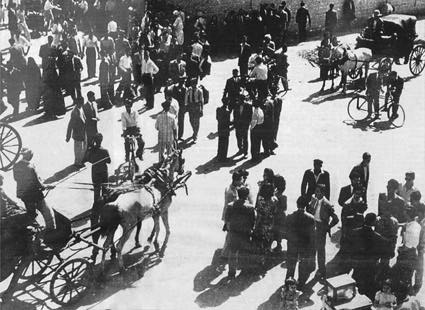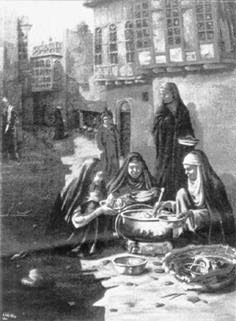The Old Jewish
Quarter of Baghdad
Excerpts from
the book: "Mine Was The Last Generation In Babylon"
by Kenneth R.
Kattan M.D.
Families and relatives
lived in the same neighbourhood. In some cases the adult sons
and their spouses stayed with parents even after they married
and had children. Each couple had one or two rooms in the
big house. All shared the same kitchen. Most of these families
lived in harmony, or at least tolerated each other.
In the thirties
and forties many started to move to the more modern neighbourhoods
in the South part of Baghdad. Some of the houses were above
the shops of the market (hanging houses).
My wife's father,
Ezra Rahima, used to dress in zeboon (gown), abaya (cloak)
and tarboush (fez). He slept usually near the window facing
the street to hear the call of the Shamash to early morning
prayers, shouting Abu Rahmin "Time for Shahrit." During weekdays
very few boys accompanied their fathers to the synagogue.
About one hour
later, the same men came home with their purchases from Souk
Hinnouni, the food market, carrying food in wicker baskets.
Men bought the meat, vegetables, eggs, bread and whatever
food was needed every day. By this time the wife had prepared
breakfast. Women did not do the buying. It was a man's duty.
Half an hour later,
after having their breakfast, Mr Rahima emerged again, this
time to go to work. Children started going to school. During
holidays the alleys became noisy with boys playing and shouting.
Jewish boys could play outside their houses in this area.
Muslims were not around to harass them. Girls played inside
the house. It would be difficult to imagine the Jewish neighbourhood
without knowing Souk Hinnouni.
Souk Hinnouni
(Hannoon market) was the heart of the Jewish neighbourhood.
It was the main food market for more than sixty thousand people
who lived in this area and it was situated inside this residential
area. All the vendors and the customers were Jews. There was
even a synagogue situated in its middle. It consisted of multiple
intersecting alleys, each not more than 3 metres in width.
They were unpaved, and they became muddy during the rainy
days, autumn and winter.
In one alley there
were four butcher shops next to each other. They sold mutton
and other parts of the sheep, mainly liver, spleen, lungs,
heart and sweetbread. The stomach, the intestines, the head
and lower parts of the legs were sold in a different shop.
The butcher went to the slaughterhouse after midnight, bought
the number of sheep he thought he would need the next morning,
had them slaughtered and took the carcasses to his shop. Each
butcher bought four to ten sheep each day. Since there was
no storage or refrigerator, the butcher had to sell all the
merchandise by noon, which he usually did.
There were four
or five shops that sold river fish from the Tigris. They were
sold fresh. There was the shabboot and the binni that were
sold whole. The bizz was very large fish up to 2 metres in
length, so it was sold by the kilo.
In another alley
of the souk there were shops selling live chickens. Nobody
bought slaughtered or dressed chicken. A full chicken was
bought. Customers felt the chicken for fat. A fat chicken
was considered better and tastier. In the same alley there
was the shohet (ritual slaughterer). After buying the chicken,
it was brought to him for slaughter. He checked the animal
for a defect or for a broken limb. Then he held the neck with
his left hand, removed a few feathers from the neck, looked
for the windpipe and the blood vessel. Then he cut with one
stroke the windpipe and the blood vessels supplying the head.
He had to do it in one stroke according to the Jewish law.
After that he threw the chicken on a container containing
ashes, in order to absorb the blood. The knife had to be very
sharp so that when it cuts the animal it would not be felt.
The artery had to be cut so that the brain would be denied
the blood supply. The animal would loose consciousness in
no time. Not everybody could be a shohet.
After passing
a test, was licensed by the "Jewish authority" who would check
his knife at regular intervals.
In another alley
there were the vegetable and fruit vendors who sold the seasonal
product. In the same alley there were the shops that sold
cheeses. Feta cheese was the most consumed cheese in Iraq.
The vendor sold thick yoghurt and butter, and qaimer (thick
cream).
All sorts of other
products and cooked food were sold in souk Hannouni. The people
who crowded the souk and brought life to it are no more there.
They and their children have been transplanted into the promised
land: Israel.
It is God's will
and the way of all flesh.
Ramat-Gan
Abraham Ben-Elyahou

Above: Street
scene in a Jewish section of Baghdad

Above: Selling
cooked fava beans in the alleyways
If
you would like to make any comments or contribute to The
Scribe please contact
us.
|